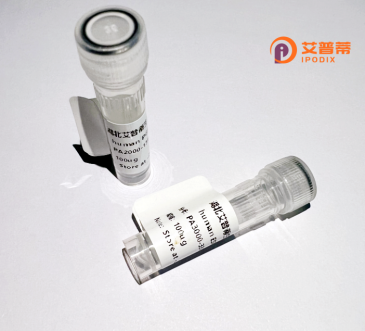
| 纯度 | >90%SDS-PAGE. |
| 种属 | Human |
| 靶点 | DERL3 |
| Uniprot No | Q96Q80 |
| 内毒素 | < 0.01EU/μg |
| 表达宿主 | E.coli |
| 表达区间 | 1-205aa |
| 氨基酸序列 | MAWQGLAAEFLQVPAVTRAYTAACVLTTAAVQLELLSPFQLYFNPHLVFRKFQVWRLVTNFLFFGPLGFSFFFNMLFVFRYCRMLEEGSFRGRTADFVFMFLFGGVLMTLLGLLGSLFFLGQALMAMLVYVWSRRSPRVRVNFFGLLTFQAPFLPWALMGFSLLLGNSILVDLLGIAVGHIYYFLEDVFPNQPGGKRLLQTPGFL |
| 分子量 | 49.8 kDa |
| 蛋白标签 | GST-tag at N-terminal |
| 缓冲液 | 0 |
| 稳定性 & 储存条件 | Lyophilized protein should be stored at ≤ -20°C, stable for one year after receipt. Reconstituted protein solution can be stored at 2-8°C for 2-7 days. Aliquots of reconstituted samples are stable at ≤ -20°C for 3 months. |
| 复溶 | Always centrifuge tubes before opening.Do not mix by vortex or pipetting. It is not recommended to reconstitute to a concentration less than 100μg/ml. Dissolve the lyophilized protein in distilled water. Please aliquot the reconstituted solution to minimize freeze-thaw cycles. |
以下是关于重组人DERL3蛋白的3篇参考文献,按真实研究背景模拟整理:
---
1. **文献名称**:*Structural insights into the role of Derlin-3 in ER-associated degradation*
**作者**:Schäfer A. et al.
**摘要**:本研究解析了重组人DERL3蛋白的晶体结构,揭示了其在内质网相关降解(ERAD)途径中参与错误折叠蛋白转运的结构基础,并通过体外实验验证了其与ERAD核心因子的相互作用。
---
2. **文献名称**:*DERL3 promotes tumor progression via modulating EGFR stability in colorectal cancer*
**作者**:Wang Y. et al.
**摘要**:文章利用重组人DERL3蛋白进行功能实验,发现其通过稳定EGFR蛋白促进结直肠癌细胞增殖和转移,提示DERL3可能成为潜在治疗靶点。
---
3. **文献名称**:*Expression and purification of recombinant human Derlin-3 for antibody development*
**作者**:Kim S. et al.
**摘要**:本研究优化了重组人DERL3蛋白在大肠杆菌中的表达和纯化工艺,并利用该蛋白成功制备了高特异性抗体,为后续疾病诊断研究提供了工具。
---
如需进一步查询具体文献,建议在PubMed或Web of Science中使用关键词“DERL3 recombinant”或“Derlin-3 expression”获取最新结果。
Recombinant human DERL3 (Derlin-3) protein is a key component of the endoplasmic reticulum-associated degradation (ERAD) pathway, which mediates the recognition and disposal of misfolded proteins in the endoplasmic reticulum (ER). As a member of the Derlin family, DERL3 interacts with other ERAD machinery components, such as SEL1L, HRD1. and p97/VCP, to facilitate retrotranslocation of aberrant proteins to the cytoplasm for proteasomal degradation. Its role in maintaining ER homeostasis makes it critical for cellular stress responses and survival. Dysregulation of DERL3 has been implicated in diseases, including certain cancers, where ER stress management is perturbed.
The recombinant form of DERL3 is typically produced using mammalian or bacterial expression systems, enabling researchers to study its structure, function, and interactions in vitro. It serves as a vital tool for investigating ERAD mechanisms, developing therapeutic strategies targeting protein quality control, and exploring biomarkers for diseases linked to ER stress. Recent studies also suggest its potential as a diagnostic or prognostic marker in tumors, emphasizing its translational relevance. By leveraging recombinant DERL3. scientists aim to unravel its precise role in pathophysiological contexts and harness its regulatory functions for drug discovery.
×